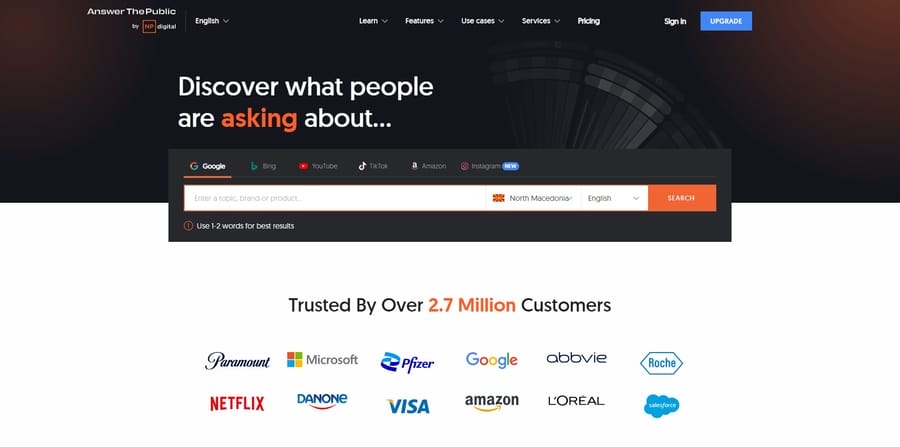How To Get Website Content From Customers: Key Highlights
-
Customer input drives clarity: The strongest content strategies begin with real customer questions, not internal assumptions.
-
Support and sales reveal gaps: Repeated issues in conversations highlight exactly where your content is falling short.
-
Turn insight into action: What your audience says and searches for should directly shape the content you create.
Did you know that only 3% of brands are defined as customer-obsessed — meaning they consistently prioritize customer needs, desires and satisfaction?
By actively listening and responding to those signals, those few companies report faster revenue growth, stronger margins and better retention.
Yet most content strategies are still built in isolation, overlooking the steady stream of insight customers share through questions, complaints and conversations.
Below, we’ll break down how to get website content from clients and create strategies that speak directly to your audience and drive long-term loyalty.
Step 1. Start With Conversations That Reveal Content Gaps
Content teams often brainstorm in a vacuum while customers are already voicing the exact questions and frustrations that should be shaping your editorial priorities.
These are the moments when expectations clash with experience — when a customer asks a question they couldn’t answer through your site, or when a sales conversation uncovers confusion that your messaging never addressed.
1. Use Surveys To Ask Directly
Surveys work when they uncover friction you didn’t anticipate — not when they confirm what you already believe.
Skip broad sentiment questions and go straight to where people struggled or gave up.
Getting content from clients starts with using these steps:
- Focus on one topic per survey and keep the language neutral to avoid steering responses
- Use one open-ended question at the end to surface ideas in the customer’s own words
If participation is low, consider a small incentive. It signals that you value their input and can increase completion without compromising quality.
2. Monitor Support Tickets And Live Chat Logs
Support channels show you what your content didn’t explain clearly enough.
If a question comes up more than twice a week, it deserves a dedicated response, especially if it touches conversion, retention or setup.
Track themes across ticket categories, then link them to missed messaging opportunities.
This approach also reflects where many brands are headed — 44% of professionals say customer experience is becoming a bigger priority and your content should follow that lead.
3. Talk To Customers During Onboarding Or Sales Calls
Sales and onboarding calls offer rare access to how customers think and speak — before they’ve been shaped by your brand language.
These conversations reveal what matters most to buyers in the moment, including:
- The concerns that slow them down
- The assumptions they bring
- The information they couldn’t find on their own
You’ll hear the exact phrases they use to describe problems, the repeated questions that signal missing content and the objections that uncover trust gaps.
Instead of treating these calls as isolated touchpoints, treat them as a diagnostic tool.
Record and review a small sample monthly, paying attention to the themes that show up again and again.
These insights should feed directly into product pages, FAQs, onboarding flows and sales-enablement content — so your messaging reflects what people need, not what you assume they already understand.
Step 2.Use Your Community To Crowdsource Content Ideas
Beyond one-on-one conversations, your broader community shows patterns individual interactions may miss.
These joint signals can guide your content planning with more clarity and relevance than internal assumptions.
1. Ask Your Email List What They Want to Learn
Email subscribers are already engaged — they’ve opted in, expect value and are more likely to respond when asked directly.
In the U.S., 54% of people say they open marketing emails because the topic or offer matches their interests, which gives you a rare chance to collect targeted input without interrupting the customer experience.
To extract actionable insights for content ideas:
- Ask one focused question tied to a real decision point or challenge
- Avoid general prompts and force clarity with specifics (“What’s the hardest part of [X]?”)
Framing your request as a collaboration — by explaining how their input will shape future content or be shared back with them — often leads to more thoughtful, relevant responses.
2. Leverage Facebook Group Join Questions
Join requests offer more than basic screening, since they give you a direct line into what your most motivated audience segments are thinking before they’ve even interacted with your brand content.
With over 3 billion active users, Facebook remains one of the most accessible places to test ideas and observe demand in real time.
Well-designed join questions reveal:
- The problems driving someone to seek out your community
- The specific topics they hope to understand or solve
- Where they currently are in terms of knowledge or experience
The responses serve both strategic and operational value to help you shape content and qualify leads with minimal effort.
Adding an optional email field converts high-intent visitors into contacts without disrupting the experience.
3. Run Strategic Polls and Q&As
Content personalization remains a top challenge — 33% of marketers struggle to produce consistently high-quality content and another 28% say adapting it to audience needs is where they fall short.
Polls and structured Q&As provide direct input, giving you ready-made angles instead of assumptions.
Choose platforms based on intent:
- Instagram Stories for rapid input tied to product or brand questions
- LinkedIn for professional validation or trend-based sentiment
- Facebook Groups for richer feedback on nuanced topics
Q&As, especially Ask Me Anything (AMAs), tend to surface deeper, more specific concerns.
A single session can yield weeks of content ideas grounded in real customer language — ideas that typically wouldn’t surface through traditional ideation alone.
Step 3. Turn Your Customers Into Content Creators
User-generated content (UGC) transforms your audience from passive consumers into active brand advocates while delivering a steady stream of authentic content ideas.
This approach creates material that resonates in ways your own marketing team simply cannot replicate.
1. Launch Strategic Hashtag Campaigns
Hashtag campaigns help surface customer experiences at scale, especially on visual-first platforms like Instagram and TikTok where people naturally share what they’re using, buying, or enjoying.
The most effective campaigns align with a feeling or outcome your product enables.
Getting copy from clients starts with these steps:
- Choose a hashtag that’s specific, emotionally resonant and free from unrelated uses
- Set clear expectations on how to participate and where their content may appear
Apple’s #ShotOniPhone campaign remains the standout example — it reframed customers as creators, produced thousands of usable images, and turned everyday photography into product proof.
2. Structure Contests That Generate Valuable Content
Contests are an effective way to activate your customer base and collect purposeful content — not random submissions, but material that aligns with your messaging and reflects actual product use.
The goal isn’t just participation, but content that can be reused across multiple touchpoints.
Choose your format based on what you want to capture:
- Photo contests build a library of real-world product imagery
- Story submissions surface emotional drivers behind purchases
- Before-and-after entries provide visual proof of transformation or value
Strong entries often reveal language, outcomes and scenarios your audience cares about, giving your team new angles to work from — without inventing them from scratch.
3. Leverage Testimonials As Content Goldmines
Buyers pay close attention to what other customers say — 47% cite reviews and testimonials as the most influential content during product research.
That makes each testimonial more than a trust signal, it’s a blueprint for what to say, how to say it and what your audience values most.
To extract full value for content creation:
- Pair written feedback with visuals that show the product in use
- Highlight measurable outcomes or specific product benefits
- Keep responses in the customer’s own words to preserve credibility
- Repurpose standout testimonials into sales materials, landing page copy or onboarding assets
When used strategically, testimonials become more than social proof — they help close the gap between what you’re communicating and what your buyers need to hear.
Step 4. Look At What Customers Are Already Searching
With 53.3% of all website traffic coming from organic search, your audience is often forming questions — and looking for answers — long before they ever land on your site.
What they search for reveals what they’re trying to understand, solve or decide, which makes it one of the most reliable signals for what to create next.
1. Use Relevant Content Exploration Tools
Search tools turn billions of daily queries into usable direction for your content planning.
Google sees over 8 billion searches per day and roughly 15% are brand new, meaning people are constantly asking questions that haven’t been formally addressed.
Tools like Google Keyword Planner, Keywords People Use and AnswerThePublic help you identify those gaps:
- Google Keyword Planner uncovers keywords tied to volume, competition and current top-performing content so you can prioritize where to focus
- Keywords People Use surfaces long-tail, intent-driven queries directly from Google autocomplete, helping you target how real users search in real time.
- AnswerThePublic organizes real search queries into specific formats — what, how, why — giving you a clearer view of the phrasing and framing your audience uses

Both tools surface ideas your internal team may never think to search for, especially those tied to early-stage curiosity or confusion.
2. Mine Your Website’s Internal Search Box
When someone searches on your site, they’re not browsing — they’re trying to find something they expected you to provide.
These queries offer a real-time audit of what your site is failing to deliver and what your content should clarify, expand or create.
Internal search data reveals:
- Specific topics your visitors assume you should cover
- Gaps in content structure or navigation
- The actual language customers use when looking for answers
This input can be used to improve page structure, add missing explanations and refine messaging.
Reviewing these queries monthly helps reduce bounce rates, shorten support cycles and guide your team toward content people are already trying to find — but can’t.
3. Explore Forums Like Reddit And Quora
Reddit and Quora offer direct access to the questions and concerns your audience is already discussing.
With over 400 million users on Quora and more than 1.36 billion on Reddit, these platforms give you scale — but more importantly, they show what people are trying to figure out when they’re not being marketed to.
Quora users tend to ask well-structured, detailed questions, looking for trusted, clear responses.
On the other hand, Reddit threads are more conversational, often surfacing raw feedback, side-by-side product comparisons, or recurring frustrations.
To leverage content from your target audience, you should:
- Look for posts starting with phrases like “How do you…”, “I’m struggling with…”, or “What’s the best way to…”
- Pay attention to upvotes and follow-up comments — they reveal which pain points matter most
These discussions often highlight questions your audience is already asking and ones your content should be answering before someone else does.
4. Monitor Competitor Content Performance
Your competitors’ top-performing content reveals what your shared audience finds valuable — and which topics are already earning attention in search.
With 45% of users not going beyond the third page of search results and only 5% digging deeper than page ten, understanding who ranks where — and why — gives you a clear view of which content engages your audience.
Tools like BuzzSumo or Ahrefs Content Explorer surface the articles generating the most backlinks, shares and visibility.
But the value isn’t in copying what’s working, but rather in identifying what’s missing.
As you analyze top-ranking pages:
- Look for repeated themes, formats
,or angles that resonate - Note what competitors aren’t explaining fully or where the coverage feels dated or generic
- Identify content gaps where your expertise or unique approach could offer a stronger alternative
The goal is to understand what earns attention and deliver something more useful.
Step 5. Repurpose And Expand On What Works
Once you’ve gathered insight from your customers, the next opportunity is often hiding in plain sight.
Your existing content library contains proven material that can be repurposed, expanded, or restructured to do more with less effort.
1. Turn FAQs Into Comprehensive Content
FAQs reflect recurring knowledge gaps — often questions your team has answered dozens of times but never fully addressed in published content.
These queries reveal where your messaging has fallen short, especially around onboarding, product clarity, or decision-stage concerns.
Instead of leaving these valuable questions with brief answers, transform each one into:
- In-depth blog posts that rank better in search results
- Step-by-step video tutorials demonstrating solutions
- Downloadable guides addressing common pain points
To make the most out of getting content from clients:
- Add direct links from FAQ answers to expanded content pieces
- Group related questions into comprehensive topic clusters
- Pay attention to the specific language customers use in their questions
| Observation | Insight | Content Opportunity | Execution Tip |
| Customers repeat the same questions | Indicates gaps in existing messaging | Turn FAQs into blog posts | Use real customer language in headlines |
| Short FAQ answers underperform | Lacks depth and search value | Create detailed walkthroughs | Include visual aids or screenshots |
| Common issues appear in onboarding | Suggests unclear feature descriptions | Build a step-by-step video series | Focus on setup, access or initial use |
| Product-related confusion is persistent | Siggests unclear feature descriptions | Develop downloadable how-to guides | Offer simple, task-based formats |
| High-value FAQs are buried or ignored | Missed opportunity or content discovery | Link FAQs to detailed resources | Place internal links where the question is |
| Topics are scattered across pages | Harder for users to explore fully | Group into topic clusters | Use hub-and-spoke structures for navigation |
This approach improves SEO by aligning content with long-tail search intent, but more importantly, it meets customers at the exact point of uncertainty, which is when clear information is most valuable.
2. Stretch One Topic Across Multiple Platforms
Your highest-performing content already has proof of audience relevance.
Repurposing it across platforms ensures that value reaches different audiences in ways that match how they consume information — whether they’re browsing, comparing or researching.
A single topic can be translated into:
- Thought leadership posts for LinkedIn, highlighting strategic insight
- Short explainer videos or reels that summarize core ideas for mobile users
- Email sequences that walk subscribers through the concept step by step
- Sales content that adapts key messages for bottom-of-funnel conversations
This approach also enables better resource planning, letting your team produce more touchpoints from fewer projects, while reinforcing consistency across channels.
3. Update High-Performing Content With Fresh Insights
High-performing content is a strong indicator of what your audience values — but that relevance doesn’t last forever.
Shifts in customer expectations, product updates, or market context can quickly make yesterday’s top content feel incomplete or outdated.
To keep it performing:
- Prioritize pages with strong traffic but declining engagement or conversions
- Replace outdated stats, add current examples
,or respond to follow-up questions that have surfaced since publication - Refine structure or clarity based on how users interact with the content
This approach is supported by how most marketers now view content investment.
83% of professionals believe it’s more effective to publish higher-quality content less often than to produce lower-quality material more frequently.
Strategic updates allow you to maintain quality, build on proven traction and extend the lifespan of content that’s already working.
Step 6. Stay Consistent With A Customer-Driven Strategy
Gathering insights is easy, but building a system that consistently turns those insights into purposeful content is where most teams fall short.
A structured approach ensures your efforts aren’t reactive, but part of a repeatable process that stays aligned with customer needs.
1. Create A Monthly Content Calendar
A monthly content calendar keeps your team focused and aligned around priorities that come from actual customer input — not guesswork.
It brings structure to your ideas, avoids reactive production cycles and ensures content is developed with intent.
To make your content calendar more effective:
- Build themes around patterns in customer questions or behavior
- Assign ownership and deadlines early to keep production accountable
- Choose formats and channels based on how different segments prefer to engage
This kind of planning allows for deeper, more strategic content development without scrambling for last-minute topics.
2. Align Content With Customer Journey Stages
As customers move through the buying process, their questions, priorities and expectations shift.
When your content meets them with the right depth and focus at each stage, it does more than inform — it helps them make confident decisions and builds credibility where it matters most.
| Stage | Content Focus | What To Create |
| Awareness | Introduce key challenges and help customers recognize their need | Educational articles, explainer videos, beginner guides |
| Consideration | Support evaluation and clarify how your solution compares | Comparison pages, case studies, detailed how-to content |
| Decision | Reinforce trust and address common objections | Testimonials, product walkthroughs, implementation previews |
Create Customer-Centric Content With Digital Silk
The businesses that thrive don’t guess what content might work — they build systems to capture, analyze and implement customer insights consistently.
This customer-first approach eliminates the struggle of content creation while building stronger audience connections.
When you listen carefully to what customers tell you — both explicitly and implicitly — you’ll learn how to get website content from clients and turn everyday interactions into revenue-focused content opportunities.
Digital Silk follows the latest industry best practices to create engaging, high-performing and conversion focused content for businesses across industries.
As a recognized digital marketing agency, our services include:
- Digital marketing
- Content creation & optimization
- SEO services
- Social media marketing
- PPC advertising
Want to create customer-first and engagement-focused content?
Contact our team, call us at (800) 206-9413 or fill in the Request a Quote form below to schedule a consultation.
"*" indicates required fields









